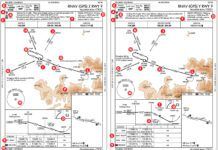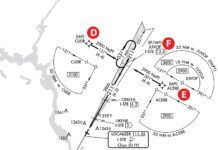These crossing points on the arc are more helpful suggestions than hard rules. How you take the hint depends on both the approach in question and your relative velocity.
Despite the quips about aviator egos barely fitting inside the cockpits that carry them, pilots have a high tolerance for following directions.
Maybe it’s because 49 times out of 50 what’s asked is what they expected anyway, so their inner know-it-all teenagers are smugly satisfied. Maybe it’s because the ones who don’t follow directions in IMC aren’t around for long.
Some directions are bold and unmistakable; others are easy to miss. Subtle suggestion fits the bill when it comes to lead radials off DME arcs.
Roundabout Route
DME arcs are one of the skills resigned to the atrophy basket for many of us. They were once a common way to save the controller some vectoring time and put navigation into a pilot’s hands. Now GPS and more ubiquitous radar coverage have made their use less common.
A typical arc uses a VOR (or sometimes NDB/DME) on the airport property for swinging the pilot around in a clean curve to intercept the final approach course. This is the old “turn 10, tune 10” technique many of us learned. Now arcs get transcribed into curving, magenta courses on our GPSs that we can just follow if we get a clearance to actually join an arc and fly the approach.
When the arc and the final approach course are determined by the same VOR, the intercept angle is always 90 degrees, because the arc is a circle around the VOR and the inbound course to the VOR is a radius of the same circle.
Of course, you don’t wait until you reach that inbound radial to start your turn because you want to turn 90 degrees and roll out on the inbound course. You lead the turn by some amount depending on how fast you’re closing on the course. The smaller the arc and the faster your groundspeed, the more lead you’ll need.
The Less-Simple Arc
Do a few of these and you get the hang of when to start a turn, but it gets more complicated when the inbound course isn’t lined up with the arc, as is the case with the ILS or LOC Rwy 13 at Hutchinson, Kan. The arc is off the Hutchinson VOR and makes two different angles on the localizer.
Moving clockwise on the arc, your intercept with the arc is less than 90 degrees, necessitating a later start to your turn to roll out cleanly on course.
Counter-clockwise on the arc, the turn is well over 90 degrees and you’d want to start early. To help out in these situations, there are lead radials on the chart, marked with an “LR,” as LR-336 and LR-321 appear for Hutchinson.
These are points on the arc when you are two miles (along the arc) from the inbound course. Note that’s miles, not degrees. The bigger the arc, the closer these radials are to this inbound course. (If you’re wondering how the 229 radial that defines OSNIE and shows where the localizer crosses the arc can be between the 336 radial and the 321 radial, it can’t. That’s an error on this current chart. Don’t believe everything you read, even from the FAA. Except what you read in IFR, of course.)
Turn Here (ish)
Contrary to common belief, the lead radial isn’t necessarily where you should start your turn. It is simply a reference point of two miles away. Your groundspeed still factors into the equation for whether two miles out is a good place to start swinging inbound. The lead radial suggests that you probably want to start thinking intercept—or really get cracking in a tailwind.
Distance rather than degrees of turn is a much more consistent mark than degrees of arc because the same amount of distance lead for a given aircraft no-wind works pretty well whether the arc radius is seven miles or 24.
Having the mark for two miles was also helpful in the pre-GPS days when the DME-based groundspeed would read zero as you flew the arc. Starting the turn 15 seconds after crossing the two-mile mark for a particular airplane would yield fairly consistent results. Good enough, anyway.
Jeppesen charts usually spell things out in greater detail than Aeronav charts, but not so with lead radials. You’ll see on the ILS or LOC Rwy 34 to Hays, Kan., lead radials appear for R-146 and R-168, but they are in light gray and not marked specifically as lead radials. Jeppesen denotes lead radials identically to radials defining intersections, as you can see for the IAFs that start these arcs.
Lead radials must be charted when the intercept is more than 90 degrees or when mandated by a flight check. The intercept angle at Hutchinson for the counterclockwise arc is 107 degrees, so there must be a lead charted and both get calculated. To see it’s 107 degrees, take the tangent to the curve at R-329, which is 239 degrees. Now subtract the inbound course 132 to see how far the course turns.
he intercept off the clockwise arc at Hays looks pretty head-on, but it’s actually 93 degrees, so it must be charted. However, even if it were perfectly aligned, flight check may request a charting because of potential or detected false signals. Some situations create a ghost localizer signal well off the correct inbound course.
Hopefully you’d notice such a big discrepancy, but a charted lead radial helps keep you in the safe zone. That’s still not to say you can turn a bit before crossing the lead radial if you have good cause to do so, but if you see them charted for a localizer intercept, it’s worth double-checking the signal you’re tracking is the right one.
It’s also worth noting that when lead radials are charted, you’ll usually see them on your IFR GPS as a waypoint. This is important because the navigator will likely start the turn at these points regardless of its normal turn anticipation and the intercepts might not be as accurate as you’re used to. You can accept that, or tweak your heading as needed until you’re established inbound.
This brings up another common error with lead radials: belief that crossing the lead radial means you’re established inbound. Not so. Both of Hays’ leads are 10 degrees different than the localizer, so the needle is still full-scale. That’s because Hays is only an 11-mile arc.
Hutchinson’s 16-mile arc has leads of seven and eight degrees, but due to the relative angles, you may have a live localizer on the clockwise arc. It’s unlikely counterclockwise. A 22-mile arc may only have a few degrees of lead and a live localizer by the time you reach the lead radial from either side. But no matter how early or late you start the turn, you may not step down to the altitude for that inbound segment until you’re truly established on that inbound course.
The point is that the leads are there for your benefit. But that’s of no use if you don’t look for the subtle messages hidden in DME arcs, or misunderstand what they signify.





